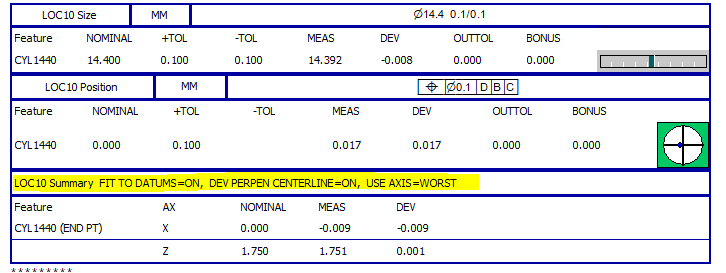This is on one of the new jobs we are running. I ran the correlation/bias study (customer results vs. our results), the Type1 and GR&R on this same program and now when I run any more than one part (same part even) I get one position dimension reporting all fubared and does not even come close to what the actual feature measures. The dimensioning is done to meet the correlation/bias study, we have all results from this study, 3 parts ran 9 times without removing the part from the fixture then we compare our average of those with the customer's measurements (must meet 10% of feature tolerance).
I am using a constructed circle from a thread locator measured as a cylinder and an offset plane (matches the customer program) and the feature actuals are well within tolerance and XactMeasure reports the first run as being where it should be but when I run this same part the second time without closing the DEMON is when the one feature (just this one, none others) tolerance jumps from .0038" TP to .017". I deleted the Xact tolerance and recreated it and it still does the same, first part is where it should be at .0038" and everything after goes to .017". I've dumped in legacy position and it does what it is supposed to do. If I quit the program and run the part again everything is as it should be (Online Mode or through Inspect) but if I run the same 2 or more time it takes a crap on me.
AHK_ALIGN =ALIGNMENT/START,RECALL:STARTUP,LIST=YES
ALIGNMENT/LEVEL,YMINUS,PL_A
ALIGNMENT/ROTATE,ZMINUS,TO,PL_H,ABOUT,YPLUS
ALIGNMENT/TRANS,XAXIS,PL_K
ALIGNMENT/TRANS,YAXIS,PL_A
ALIGNMENT/TRANS,ZAXIS,PL_H
ALIGNMENT/END
THD_LAT_2 =FEAT/CIRCLE,CARTESIAN,OUT,YES
THEO/<0.4565+0,-0.4,-0.9>,<0,-1,0>,0.197
ACTL/<0.4581,-0.4,-0.8989>,<0.0018231,-0.9999928,-0.0033329>,0.1972
CONSTR/CIRCLE,INTOF,THD_LAT_22,PL_A_OFFSET
BALLOON_40 =POSITION : THD_LAT_2
FEATCTRLFRAME/SHOWNOMS=YES,SHOWPARAMS=YES,SHOWEXPANDED=YES,
CADGRAPH=OFF,REPORTGRAPH=OFF,TEXT=OFF,MULT=10.00,ARROWDENSITY=100,OUTPUT=BOTH,UNITS=IN,
COMPOSITE=NO,FIT TO DATUMS=NO,DEV PERPEN CENTERLINE=ON,OUTPUT ALIGNMENT=Current Alignment
CUSTOMIZED DRF=NO
STANDARDTYPE=CUSTOM
PRIMARY DIMENSION/POSITION,DIAMETER,0.015,<MC>,A,H,K
SECONDARY DIMENSION/,<tol>,<MC>,<dat>,<dat>,<dat>
NOTE/BALLOON_40
FEATURES/THD_LAT_2,,
THD_LAT_2
X:NOM=0.4565
Z:NOM=0.9
<NEW>
DIM REF_40A= POSITION OF CIRCLE THD_LAT_2 UNITS=IN ,$
GRAPH=OFF TEXT=OFF MULT=10.00 OUTPUT=BOTH FIT TO DATUMS=OFF DEV PERPEN CENTERLINE=OFF DISPLAY=DIAMETER
AX NOMINAL +TOL -TOL BONUS MEAS OUTTOL DEV
X 0.4565 0.4581 0.0016
Z 0.9000 0.8989 -0.0011
TP RFS 0.0150 0.0000 0.0038 0.0000 0.0038 --#------
END OF DIMENSION REF_40A
I've told the bosses that for these 4 threaded holes I am removing the Xact dimensioning and going with legacy dimensioning (it never fails for RFS) unless I can get it figured out. Before we submit FAL to the customer we have to supply them with all of the working inspection programs and I need to get this nailed down.
I'm open to any and all ideas.
TIA
Duane





